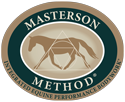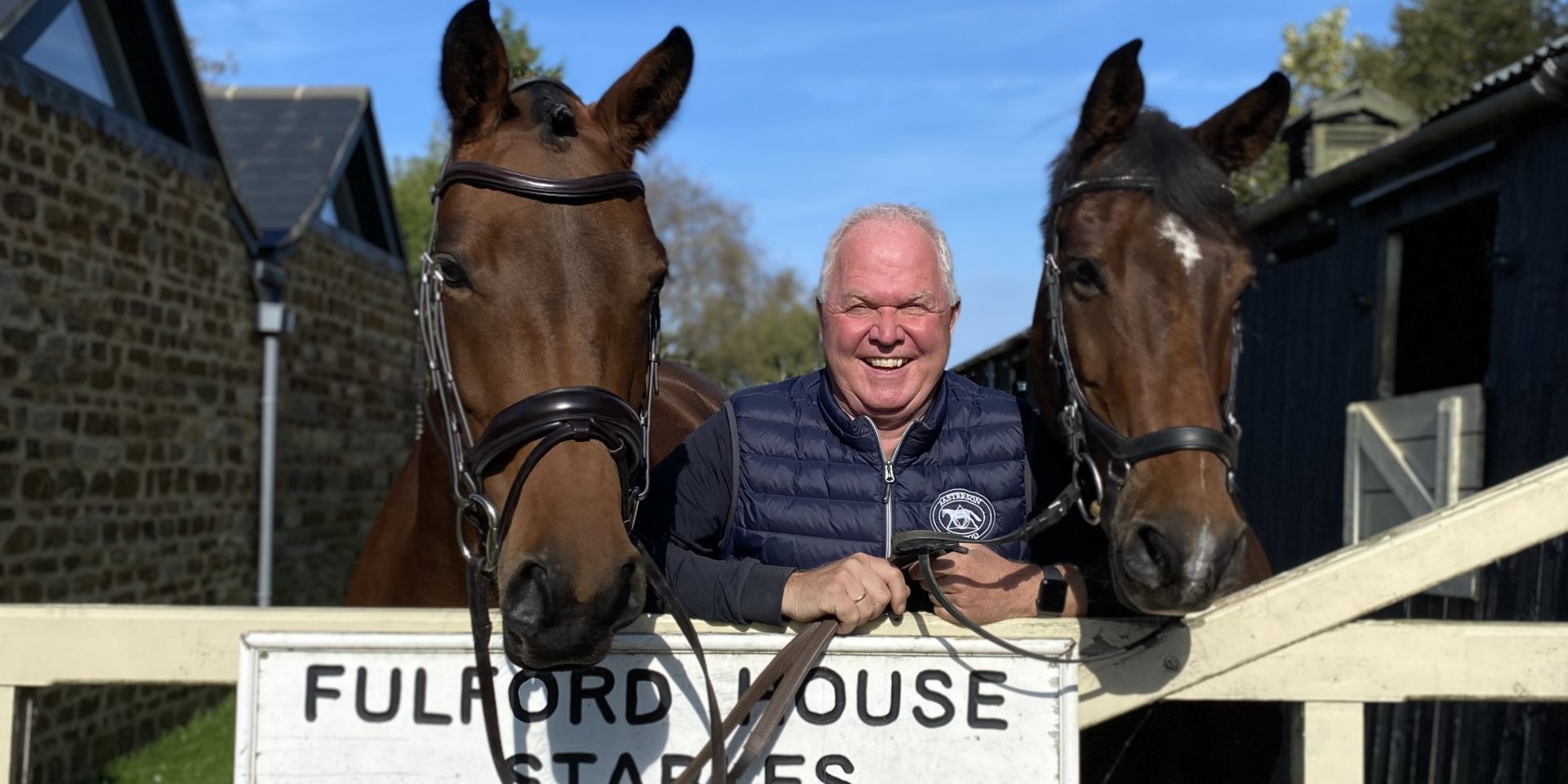by Walter Saxe
If someone had predicted ten years ago where my Masterson Method® journey would lead me in 2024, I would have thought they were crazy. Now I am facing the best experience one can imagine as a horse therapist. In two weeks, I will be taking care of the horses of the Polish Eventing National Team at the Olympic Games in Paris.
For the past three years, I have been officially working as a physiotherapist for eventing horses for the Polish Equestrian Federation, supporting them at all relevant competitions and training camps. I have been involved in European and World Championships, gaining endless experience with sports horses at this world-class level. A year ago, the national team qualified for the Olympics in Barborowko.
My primary role is to improve the performance of the four-legged athletes a little each day (enhancing range of motion and resolving restrictions), eliminate acute reactions during eventing, and keep the muscular cushioning system intact.
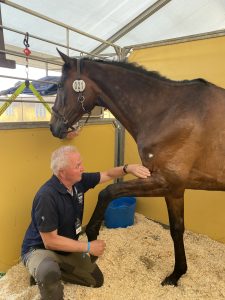
Walter at Work
The different demands on the horse’s body throughout the three disciplines – dressage, jumping, and cross-country – are extreme. It’s no coincidence that eventing is called “Concours Complet” in French, or the “complete competition discipline”. You need a “complete”, fully functioning horse to succeed, and you have to learn to manage the horse’s body through training phases and competitions. Every horse has its history, weak points, or old injuries to compensate for. The vet check before and after the cross-country is more nerve-wracking for me than the competition itself!
I use only my hands and the Masterson Method exclusively during my work because I am convinced that’s all it takes to support a sports horse. With each horse, this conviction grows. A rider once told the trainer: “Walter doesn’t seem to do anything spectacular, yet I have a totally different horse under my saddle!”. You can’t express the principle of “less is more” any better. Of course, I detect compensation patterns and thus reveal physical issues which sometimes are a vet problem, and then I step back.
Uncovering Issues in the Body
We have great tools in our Masterson Method® toolbox. The most important tool as a Masterson Method Certified Practitioner is the palpation evaluation. At every session, I use this tool as if I am seeing the horse for the first time, reevaluating each time to address the current reactions and restrictions. Naturally, you repeatedly encounter the same symptoms (in that case, seek to discover what the primary issue may be that is causing these patterns). However, the new symptoms are the ones that should disappear through the bodywork session first. Once for instance, a mare couldn’t lift her left hind leg after the winter break, and for months, when the farrier came, she was sedated to allow him to do his work. The vet had no explanation. My thoughts were: why doesn’t she want to lift the leg? It could be that she doesn’t want to stand on the other leg. So, I treated the right leg: I did releases for the psoas muscle group and the groin, accordions on the gluteus, and a technique MMCP’s and Masterson Method students use called ‘Stifle In/Stifle Out. After two sessions, there were significant improvements and the studs on the left could be easily screwed in again. Bingo!! Conclusion: don’t just treat the symptoms but find the cause.
Optimizing Performance for Each Discipline
Each discipline has its requirements. For Olympic horses and eventing horses, these are the things I look to improve with each treatment and for each discipline and also to prepare for the vet check.
Dressage
I closely observe the horse’s dressage training sessions or review the dressage protocols and work to improve their performance using specific Masterson Method techniques. Half-passes and flying lead changes in particular benefit from techniques that help release tension in the Scapula, Psoas, and a technique we call Hind-end Yoga. The mobility of the loins to both sides is particularly important in these movements. The better you understand the biomechanics, the more you can improve the dressage. It is all very logically explainable why something works well or less well, and I can describe to the rider what the horse should feel like when being ridden when I have treated their horse. Always rememeber that we reset the muscle memory of pain when we extend the range of motion in a relaxed state. I always try to align the weaker side with the better side!
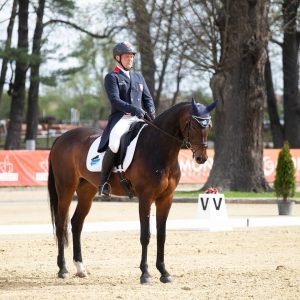
Polish team member Paweł Warszawski and Lucinda ex Ani 4 preparing for dressage
Cross-Country
Before the cross-country ride, proprioception and the forelimbs’ shock absorption system are my main priorities as a bodyworker. What these horses accomplish is breathtaking. They see this course for the first time (the rider has walked it four times or more), they must have full trust in their rider, and yet ultimately decide for themselves how to master a jump. This requires intelligence, fast reactions, and a will to perform. The physical load is enormous, with varying ground conditions. Take-off and landing points are angled or deep. The bodies are often twisted to get over narrow corners or jumps. In short, this is the pinnacle of equestrian sports. To prepare for all this, I relax the shoulder girdle and shoulders (shock absorption system), loosen the back and spinal muscles (proprioception) and relax and mobilize the temporomandibular joint and hyoid apparatus (sense of balance) about 1-2 hours before the start of a 30-minute Masterson session.
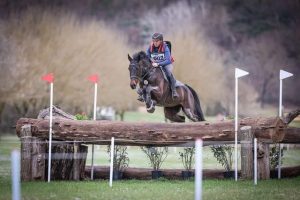
Polish team member Robert Powala riding cross country with Tosca del Castegno
Final Vet Check
The preparation for the last vet check is high time for the Masterson Method. About 2 hours after their cross-country ride, I check every horse. By now, I know every muscle of my equine buddies and know where I may or may not release compensations. Every “ouch” from the evaluation must be eliminated or at least alleviated! In the evening, we (myself, the trainer, and the team vet) look at the horses in motion. Some gait irregularities may come from blocked vertebrae anywhere between the seventh cervical and the twelfth thoracic vertebrae. Fortunately, it’s not always a joint or tendon injury. I also check the entire body for hidden abrasions that could restrict movement. After this, we decide on the next steps. “Make the pelvis more mobile; it’s still a bit stiff,” says the vet, for example. Some sessions go on into the night to ensure a safe check the next morning. This is my stress discipline.
Show Jumping
Before the final jumping, again it’s the shoulders, back, and psoas muscles that help with quick reflexes, good bascule and opening the hind legs over the jump. So, every day I spend at least an hour with each horse. It is so fascinating what a trusting relationship and deep connection I have developed over the past years with each horse. All the horses know that they are my true superstars and want to be treated as such.
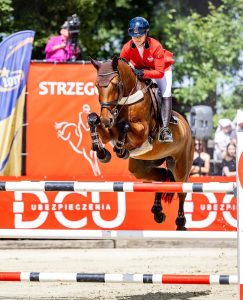
Malgorzata Korycka and Canvalencia
Finale: Ready for Paris!
And now, the riders and horses are nominated for the Olympics. They are heading to the training camp and then on to Paris. Three horses are part of the team. There are no more scratch results; every horse and rider combination counts and they should complete this competition healthy. Fingers crossed!!
One thing is already clear, no matter how it turns out for the riders, horses, and me, it will be a once-in-a-lifetime experience.
Let’s hit the road to Paris!

This article was written by Walter Saxe – MMCP, Masterson Method Mentor, Coach and Instructor. Walter is based in Germany and his love for horses began as a child.
By chance, he read about The Masterson Method and was immediately thrilled. He bought the book and DVD and started his awesome journey into horses’ body and soul. The weekend seminar, the advanced course, fieldwork studies and certification lasted 19 months. He’s fascinated by the gratefulness and deep connection that’s built up with all the horses he works with. Walter’s biggest aim is that many horse people in Germany experience The Masterson Method for their horses and start to learn it for themselves.
For more information on the author, go to Walter Saxe, MMCP, Mentor, Coach, Instructor
